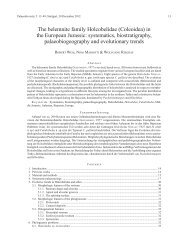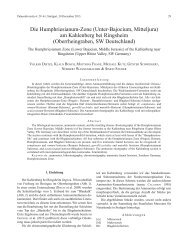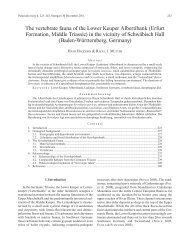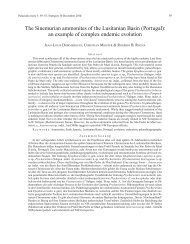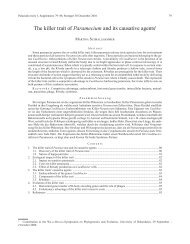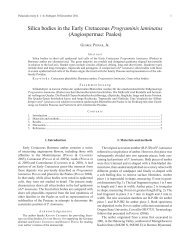Juraphyllites mimatensis (D'ORBIGNY, 1845 ... - Palaeodiversity
Juraphyllites mimatensis (D'ORBIGNY, 1845 ... - Palaeodiversity
Juraphyllites mimatensis (D'ORBIGNY, 1845 ... - Palaeodiversity
You also want an ePaper? Increase the reach of your titles
YUMPU automatically turns print PDFs into web optimized ePapers that Google loves.
<strong>Palaeodiversity</strong> 1: 133–140; Stuttgart, 30.12.2008. 133<br />
<strong>Juraphyllites</strong> <strong>mimatensis</strong> (d’Or b i g n y, <strong>1845</strong>) (Ammonoidea:<br />
Phylloceratida), a Tethyan immigrant in the Upper Pliensbachian of<br />
Franconia (Jurassic, Southern Germany)<br />
He l m u t Ke u pp & gü n t e r Sc H w e i g e r t<br />
Abstract<br />
Two well-preserved small-sized specimens of phylloceratoid ammonites are reported from the Late Pliensbachian<br />
Spinatum Zone of Franconia. They are assigned to <strong>Juraphyllites</strong> (cf.) <strong>mimatensis</strong> (d’Orb i g n y, <strong>1845</strong>) and regarded<br />
as Tethyan immigrants. Due to their very similar early ontogenetic stages it seems impossible to distinguish<br />
tiny juveniles of <strong>Juraphyllites</strong> <strong>mimatensis</strong> (d’Orb i g n y, <strong>1845</strong>) from those of contemporaneous Meneghiniceras eximium<br />
(v. Ha u e r).<br />
Key words: Phylloceratina, Early Jurassic, palaeobiogeography, immigration, Franconia, Germany.<br />
Zusammenfassung<br />
Zwei gut erhaltene kleinwüchsige Exemplare phylloceratoider Ammoniten werden aus der Spinatum-Zone des<br />
Ober-Pliensbachium von Franken beschrieben. Sie werden zu <strong>Juraphyllites</strong> (cf.) <strong>mimatensis</strong> (d’Orb i g n y, <strong>1845</strong>) gestellt<br />
und als tethyale Einwanderer angesehen. Wegen ihrer sehr ähnlichen frühontogenetischen Stadien erscheint<br />
es praktisch unmöglich, sehr kleine Individuen von <strong>Juraphyllites</strong> <strong>mimatensis</strong> (d’Orb i g n y, <strong>1845</strong>) von solchen des<br />
gleich zeitig vorkommenden Meneghiniceras eximium (v. Ha u e r) zu unterscheiden.<br />
1. Introduction<br />
The dark claystones of the Upper Pliensbachian<br />
Amaltheenton Formation of Southern Germany, particularly<br />
of Franconia, yield a relatively low diverse ammonite<br />
fauna, generally dominated by the Subboreal family of the<br />
Amaltheidae. Rare immigrations of various Tethyan or<br />
Euroboreal ammonite taxa seem to be restricted to short<br />
phases of sea level highstands, as recently pointed out by<br />
Sc H w e i g e r t (2005) and Ke u pp & Sc H O b e r t (2008). These<br />
exotic ammonites attracted special attention and were noted<br />
by numerous former authors (see Sc H w e i g e r t 2005 for<br />
references; ma i S c H 2007).<br />
Soon after the publication of some findings of juvenile<br />
phylloceratids from the clay-pit of Buttenheim in Franconia<br />
(Ke u pp & Sc H O b e r t 2008), two somewhat larger specimens<br />
were found by the amateur collector JO H a n n Sc H O <br />
b e r t (Hirschaid). Both specimens exhibit diameters of 30<br />
and 43 mm, respectively, and are assigned to the unkeeled<br />
juraphyllitid taxon <strong>Juraphyllites</strong> (cf.) <strong>mimatensis</strong><br />
(d’Orb i g n y, <strong>1845</strong>). This taxon, which is of Tethyan origin,<br />
was previously unknown from the Pliensbachian of Southern<br />
Germany. The new findings, which question earlier<br />
determinations of juveniles, stimulated this study.<br />
Acknowledgements<br />
JO H a n n Sc H O b e r t (Hirschaid) is thanked for his generous<br />
donation of his interesting findings for this study. The journals’<br />
referees JO a c H i m bl a u (Gießen) and cH r i S t i a n me i St e r (Genève)<br />
are thanked for their advice and suggestions.<br />
2. Provenance of the studied material<br />
The Middle Liassic Amaltheenton Formation (Upper<br />
Pliensbachian) of Franconia crops out in the western foreland<br />
of the Northern and Middle Franconian Alb and is<br />
exposed in several clay-pits. Today most of them are abandoned<br />
(e. g., Kalchreuth: ri c H t e r 1993; Marloffstein:<br />
plü c K e bau m 1985; Sc H m i d tKa l e r 2004; Reichenschwand:<br />
Haa r l ä n d e r 1961; Schnaittach: vO i g t 1968; Unterstürmig:<br />
ri c H t e r 1977, 2000; plü c K e bau m 1985). The only<br />
still active clay-pit of the Liapor Company in this area lies<br />
in the Oberfranken district, about 1 km SSE of Buttenheim.<br />
This clay-pit substitutes the former clay-pit of Unterstürmig<br />
which was located only 1.5 km to the south.<br />
The latter outcrop became popular by the occurrence of<br />
well-preserved white-coloured amaltheids bearing their<br />
original aragonitic shells (du l l O 1981). The stratigraphic<br />
sections exposed in both clay-pits are almost identical<br />
(ri c H t e r 2003; HOf f m a n n et al. 2007). In the former claypit<br />
of Unterstürmig especially the upper part of the Spinatum<br />
Zone of the Upper Pliensbachian and the Lower Toarcian<br />
was exposed; only from time to time expanding<br />
downwards to the Apyrenum Subzone of the Upper Pliensbachian.<br />
In contrast, the clay-pit near Buttenheim exposes<br />
primarily beds of the Gibbosus and Apyrenum subzones,<br />
expanding upwards during the progress of the last two<br />
years to the upper part of the Spinatum Zone and the base<br />
of the Lower Toarcian Posidonia Shale (Fig. 1). Also in the<br />
clay-pit of Buttenheim well-preserved ammonites occur
134 pa l a e O d i v e r S i t y 1, 2008<br />
Fig. 1. Geographical position und section of the clay pit near Buttenheim. The horizon where the <strong>Juraphyllites</strong> <strong>mimatensis</strong> (d’Orb i g n y,<br />
<strong>1845</strong>) illustrated in Fig. 3 was found is marked by an asterisk.
with their primary aragonitic shells, sometimes, especially<br />
within beds of the Apyrenum Subzone, showing a colour<br />
pattern formed by dark, sub-concentric dotted spiral lirae<br />
(ri c H t e r 2003; Ke u pp 2005; Ke u pp & Sc H O b e r t 2008).<br />
Within a collection of ca. 17.000 ammonites from the<br />
Upper Pliensbachian of Buttenheim there are only less than<br />
ten phylloceratids, most of them juveniles. The first phylloceratid<br />
specimen described in this study was originally<br />
included in a small calcareous concretion. It was collected<br />
by J. Sc H O b e r t (Hirschaid) in early March 2008 in the<br />
higher section of the clay-pit of Buttenheim. It came from<br />
undisturbed sediments 20 cm below the main fossiliferous<br />
horizon of the upper Spinatum Zone (= Hawskerense Subzone).<br />
The predominant ammonites of this level are the<br />
different morphotypes of Pleuroceras spinatum (Br ug<br />
u i è r e) which occur mainly in the directly overlying beds.<br />
The second specimen was found loose also by J. Sc H O <br />
b e r t, together with dispersedly distributed amaltheids of<br />
the Apyrenum Subzone in early spring 2007.<br />
The studied ammonites are housed in the Institute of<br />
Geological Sciences, Freie Universität Berlin, collection<br />
Ke u pp, numbers MAn-3111 and MAn-3115.<br />
3. Systematic palaeontology<br />
Suborder Phylloceratina arK e l l, 1950<br />
Superfamily Phylloceratoidea Zi t t e l, 1884<br />
Family Juraphyllitidae arK e l l, 1950<br />
Genus <strong>Juraphyllites</strong> mü l l e r, 1939<br />
Ty pe species: Phylloceras diopsis ge m m e l l a rO, 1884.<br />
K e u p p & S c H w e i g e rt, j u r a p h y l l i t e s m i m a t e n s i s in S O u t H e r n g e r m a n y 135<br />
Remarks. – In several recent publications dealing<br />
with Juraphyllitidae, the genera Meneghiniceras Hya t t,<br />
1900, Harpophylloceras Spa t H , 1927, and <strong>Juraphyllites</strong><br />
mü l l e r, 1939 were considered to be synonymous or of<br />
subgeneric rank (e. g., me i St e r 1989; ma c c H i O n i 2001;<br />
ma c c H i O n i in pav i a & cr e S ta 2002; ma c c H i O n i & me i St e r<br />
2003). Indeed, Harpophylloceras can be easily included in<br />
Meneghiniceras (Sc H w e i g e r t 2005), but the latter differs<br />
from other Juraphyllitidae by the presence of a keel in the<br />
adult stage. Therefore we maintain the genus <strong>Juraphyllites</strong><br />
for the forms lacking a keel.<br />
<strong>Juraphyllites</strong> <strong>mimatensis</strong> (d’Orb i g n y, <strong>1845</strong>)<br />
Figs. 2–3, ? 4<br />
* <strong>1845</strong> Ammonites Mimatensis, d’Orb i g n y, 1844. –<br />
d’Orb i g n y, p. 344, pl. 110, figs. 4–6.<br />
1856 Ammonites Mimatensis, d’Orb., <strong>1845</strong>. – Oppe l,<br />
p. 252.<br />
1929 Rhacophyllites spec. ex aff. <strong>mimatensis</strong> Or b. –<br />
gu g e n b e r g e r , p. 255, pl. 10, fig. 5, pl. 11, fig. 6,<br />
pl.12, fig. 10.<br />
? 1930 Rhacophyllites cf. <strong>mimatensis</strong> (d’Orb i g n y). –<br />
mO n e S t i e r , p. 8, pl. 11, fig. 1.<br />
1934 Rhacophyllites <strong>mimatensis</strong> (d’Orb i g n y). – mO n e St<br />
i e r, p. 16, pl. 5, figs. 17, 19, 24–30, 34–35.<br />
1934 Rhacophyllites libertus (ge m m e l l a rO). – mO n e St<br />
i e r, p. 17, pl. 6, figs. 1, 6.<br />
? 1934 Rhacophyllites <strong>mimatensis</strong> (d’Orb i g n y) var. vinensis.<br />
– mO n e S t i e r , p. 17, pl. 5, figs. 36–37.<br />
pars 1963 Rhacophyllites <strong>mimatensis</strong> (d’Orb i g n y). – Sg u a Z<br />
Z O n i, p. 46, pl. 21, fig. 10, non fig. 4.<br />
? 1970 <strong>Juraphyllites</strong> libertus (ge m m e l l a rO). – br a m b i ll<br />
a, p. 262, pl. 55, fig. 2.<br />
1977 <strong>Juraphyllites</strong> <strong>mimatensis</strong> (d’Orb i g n y). – wi e d e nm<br />
a y e r , p. 36, pl. 1, figs. 3, 8b.<br />
Fig. 2. <strong>Juraphyllites</strong> <strong>mimatensis</strong> (d’Orb i g n y, <strong>1845</strong>), holotype, lost; reproduction of d’Orb i g n y’s illustration; Upper Pliensbachian; Mt.<br />
Mimat, Dept. Lozère, France. Diameter 42 mm.
136 pa l a e O d i v e r S i t y 1, 2008<br />
Fig. 3. <strong>Juraphyllites</strong> <strong>mimatensis</strong> (d’Orb i g n y, <strong>1845</strong>); Pliensbachian, upper part of the Spinatum Zone, Hawskerense Subzone; Buttenheim,<br />
northern Bavaria, Germany; MAn-3111. 29.2 mm in diameter. – A. Lateral view. B. Ventral view. C. Oblique view showing<br />
the large missing shell fragment due to a presumed crustacean attack. D. Close-up of Fig. 3A showing the suture line.<br />
1989 <strong>Juraphyllites</strong> <strong>mimatensis</strong> (d’Orb i g n y). – me i St e r,<br />
p. 30, pl. 2, fig. 10, pl. 3, figs. 4, 17a, b.<br />
1994 <strong>Juraphyllites</strong> <strong>mimatensis</strong> (d’Orb i g n y). – JO ly in<br />
fi S c H e r, p. 98, fig. 31, pl. 27, figs. 3a–c, 4.<br />
2000 <strong>Juraphyllites</strong> <strong>mimatensis</strong> (d’Orb i g n y, <strong>1845</strong>). –<br />
JO ly, p. 29–30, figs. 41–43, pl. 3, fig. 6a, b.<br />
Types: <strong>Juraphyllites</strong> <strong>mimatensis</strong> was first described by<br />
d‘Orb i g n y (1865) from the Upper Pliensbachian of Southern<br />
France and named after the type locality, the Mont Mimat south<br />
of Mende (Dept. Lozère). Because of the apparent lost of the<br />
type specimen originally housed in the re n a u x collection in<br />
Montpellier, JO ly (in fi S c H e r 1994) designated a neotype, a<br />
mould coming from the middle Upper Pliensbachian (Margaritatus<br />
Zone) of Mt. Guilhaumard near Tournadous. This neotype,<br />
however, is much less complete than the lost holotype, following<br />
the illustration by d’Orb i g n y (<strong>1845</strong>) (Fig. 2).<br />
Occur rence: From different localities of the Grands Caus-
ses (Southern France, e. g., d’Orb i g n y <strong>1845</strong>; Oppe l 1856; mO n e St<br />
i e r 1934; me i St e r 1989; JO ly in fi S c H e r 1994, JO ly 2000),<br />
Turkey (gu g e n b e r g e r 1929); ? Morocco (mO n e S t i e r 1930), ?<br />
West-alpine Italy (br a m b i l l a 1970), South-alpine Switzerland<br />
(wie d e n m a y e r 1977), Apennines (Sg u a Z Z O n i 1963), and Franconia<br />
(herein).<br />
Stratigraphic range: Late Pliensbachian (Stokesi to<br />
Hawskerense subzones), possibly already present in the upper<br />
Early Pliensbachian (Davoei Subzone), see wi e de n m ay e r (1977).<br />
In the Causses region this taxon is only reported from the Subnodosus<br />
to Gibbosus subzones (me i St e r 1989), but unknown yet<br />
from the Spinatum Zone.<br />
Descriptions. – The first and smaller one of the two<br />
studied specimens (MAn-3111) measures 29.2 mm in diameter.<br />
The phragmocone of this completely preserved<br />
specimen is slightly compressed by compaction processes,<br />
whereas its body chamber (last ½ whorl) does not show<br />
any diagenetic deformation (Fig. 3). However, on one of<br />
the flanks, the body chamber has lost a large angular piece<br />
of the shell affecting the entire flank and reaching from<br />
the peristome about 16 mm backwards. Obviously this<br />
specimen was attacked by a predator, possibly a benthic<br />
crustacean. Due to this large artificial opening of the body<br />
chamber, the measurements characterizing the shell morphology<br />
was taken along the smaller diameter of 24.2 mm<br />
(see below). On the surface of the mould some relics of the<br />
white aragonitic shell material are still preserved. The<br />
slightly compressed phragmocone shows the characteristic<br />
juraphyllitid suture line (Fig. 3D) which matches perfectly<br />
with that of the lost holotype illustrated by d’Orb i g n y<br />
(1865; Fig. 2) and the illustrations of the suture lines of the<br />
neotype and additional material from the Causses provided<br />
by JO ly (in fi S c H e r 1994) and JO ly (2000). Moreover,<br />
also the measurements fall within the size ranges of the<br />
specimens from the Causses (JO ly 2000; see Tab. 1). The<br />
umbilicus of the specimen from Buttenheim is only slightly<br />
smaller, and the cross-section of the whorl is insignificantly<br />
broader. Surprisingly, the holotype (Fig. 2) is the<br />
closest one to our present finding although later authors<br />
stated that the illustration by d’Orb i g n y could be somewhat<br />
generalized.<br />
K e u p p & S c H w e i g e rt, j u r a p h y l l i t e s m i m a t e n s i s in S O u t H e r n g e r m a n y 137<br />
Tab. 1. Measurements of specimens related to <strong>Juraphyllites</strong> <strong>mimatensis</strong> (d = diameter; u = umbilicus; wh = whorl height; ww = whorl<br />
width).<br />
MAn-3111<br />
(Fig. 3)<br />
MAn-3115<br />
(Fig. 4)<br />
specimen<br />
Neotype<br />
(JO ly in fi S c H e r 1994)<br />
Coll. JO ly no. 99-1 Cornus<br />
(JO ly 2000)<br />
Coll. JO ly no. 140-1 Puech<br />
(JO ly 2000)<br />
d u u/d wh wh/d ww ww/d ww/wh<br />
(mm)<br />
29.2<br />
(mm) (%) (mm) (%) (mm) (%) (%)<br />
24.2 6.6 27 11.6 48 7.9 32.5 68<br />
43 6.8 15.8 24.0 56 12.1 28 50<br />
34.5 10 29 16 46 9.8 28 61<br />
27.3 8.8 32 12.3 45 7.3 27 59<br />
22 6.8 31 9.7 44 6 27 62<br />
On the body chamber simple ribs occur, running<br />
slightly convex over the flattened flanks, and disappear on<br />
the rounded venter. Immediately behind the peristome, the<br />
ribs tend to become fastigate. The almost smooth venter<br />
does not show any indication of a keel. Within the umbilicus<br />
about six constrictions per whorl are discernible which<br />
seem to disappear successively after a diameter of ca.<br />
18 mm.<br />
The incompletely preserved second specimen (MAn-<br />
3115, Fig. 4) has a diameter of ca. 43 mm. It exhibits a<br />
nearly completely preserved and uncrushed body chamber<br />
(last half whorl). The phragmocone has been collapsed by<br />
compaction processes and was lost along the first half of<br />
the outer whorl, but is still visible within the open umbilicus.<br />
The weak ribs run more or less radially over the flattened<br />
flanks of the body chamber and cross the rounded<br />
venter along the last ¼ whorl in a fastigate style. Within<br />
the open umbilicus, up to six constrictions per whorl are<br />
discernible. The body chamber itself does not show any<br />
constrictions. The morphology differs from the previously<br />
described specimens of <strong>Juraphyllites</strong> <strong>mimatensis</strong> especially<br />
in the measurements of the umbilicus, which is significantly<br />
narrower, with a relative width of about 16 %<br />
versus 27–32 %, and the cross-section of the whorl which<br />
appears to be higher (ww/wh = 50 % versus 59–68 %).<br />
Only the umbilical elements of the last suture line are preserved<br />
just at the beginning of the body chamber showing<br />
a characteristic juraphyllitic pattern formed by short amplitudes.<br />
From the suture line aspect, this specimen is<br />
clearly distinguishable from the contemporaneous phylloceratid<br />
genus Zetoceras. In the latter, a similarly narrow<br />
umbilicus is developed, but its suture line is much more<br />
complex, with high amplitudes (see JO ly 2000). The suture<br />
line, ribbing sculpture, and the lacking of a keel of this<br />
specimen correspond with <strong>Juraphyllites</strong> <strong>mimatensis</strong>. However,<br />
due to the significantly smaller umbilicus and the<br />
higher whorl-section we prefer a cf.-determination of this<br />
specimen.
138 pa l a e O d i v e r S i t y 1, 2008<br />
Fig. 4. <strong>Juraphyllites</strong> cf. <strong>mimatensis</strong> (d’Orb i g n y, <strong>1845</strong>); Pliensbachian, Spinatum Zone, ? Apyrenum Subzone; Buttenheim, northern<br />
Bavaria, Germany; MAn-3115. – A. Lateral view. B. Ventral view. – Scale: 2 cm.<br />
4. Palaebiogeography of <strong>Juraphyllites</strong> <strong>mimatensis</strong><br />
(d’Or b i g n y, <strong>1845</strong>)<br />
Without any doubt <strong>Juraphyllites</strong> <strong>mimatensis</strong> represents<br />
a Tethyan faunal element of the Late Pliensbachian which<br />
immigrated only during sea-level highstands and favourable<br />
currents into adjacent epicontinental basins, such as<br />
the Causses area of Southern France and reached even<br />
Southern Germany (see above). The records of this species<br />
in true Tethyan deposits are still remarkably scarce and<br />
seem to be restricted to the Western Tethys. However, it is<br />
not unlikely that this species is much more widespread but<br />
still unrecognized (see wi e de n m ay e r 1977: 37), because in<br />
early ontogenetic stages this form is hardly distinguishable<br />
form other juraphyllitids such as Meneghiniceras eximium<br />
(v. Ha u e r) and <strong>Juraphyllites</strong> libertus (ge m m e l l ar<br />
O).<br />
5. Previously described juvenile Phylloceratina from<br />
the Upper Pliensbachian of Southern Germany<br />
Qu e n S t e d t (1885) described and illustrated tiny phylloceratids<br />
from the Amaltheenton Formation (“Lias δ”) of<br />
Gross-Eislingen (today: Eislingen) in Swabia as “Ammonites<br />
tortisulcoides”. Other records assigned to this species<br />
have been recorded from Southern Germany by Zw i e<br />
Se l e (1898), en g e l (1908), ur l i c H S (1977), plü c K e bau m<br />
(1985), and Sc H l e g e l m i l c H (1976). On the other hand,<br />
HO w a r t H (1976) reported on a single excellently preserved<br />
finding of the keeled juraphyllitid Meneginiceras eximium<br />
(Ha u e r , 1854) var. lariense (me n e g H i n i, 1874) from the<br />
Lower Toarcian of the British Yorkshire coast. The innermost<br />
whorls of Meneghiniceras have not developed the<br />
characteristic ventral keel of later ontogenetic stages and<br />
hence they correspond morphologically well with the<br />
small and partly still unkeeled specimens of Ammonites<br />
tortisulcoides Qu e n S t e d t. As a consequence, Sc H w e i g e r t<br />
(2005) interpreted the taxon Ammonites tortisulcoides<br />
Qu e n S t e d t, 1885 as a subjective junior synonym of Meneghiniceras<br />
eximium (v. Ha u e r , 1854) due to the tendency<br />
to form a ventral keel with increasing diameters in most<br />
of his specimens of Ammonites tortisulcoides under study.<br />
Interestingly, mO n e S t i e r (1934) interpreted a specimen<br />
from Swabia figured by pOm pe c K J (1893, pl. 1, figs. 10–11)<br />
as belonging to d’Orb i g n y’s species <strong>mimatensis</strong>, but he<br />
overlooked the keeled venter of this specimen. The presence<br />
of a keel also in the lectotype of Ammonites tortisulcoides<br />
confirms the supposed synonymy of the two taxa.<br />
Ke u pp & Sc H O b e r t (2008) recorded for the first time several<br />
very small, juvenile phylloceratid phragmocones, all<br />
of them less than 1 cm in diameter, from the Apyrenum<br />
Subzone of Buttenheim. Following the argumentation<br />
given by Sc H w e i g e r t (2005), these innermost whorls were<br />
also determined as juveniles of the juraphyllitid Meneghiniceras<br />
eximium (Ha u e r) although a keel is not developed<br />
in any of these tiny specimens. In Swabia, Meneghiniceras<br />
eximium (v. Ha u e r) occurs as an iteratively immigrating<br />
Tethyan guest in the Late Pliensbachian, but it was<br />
never recorded from the Spinatum Zone.
However, with the herein described specimens of <strong>Juraphyllites</strong><br />
<strong>mimatensis</strong>, a second juraphyllitid species is<br />
now reported which immigrated from the Tethyan into the<br />
epicontinental shallow sea of Southern Germany during<br />
the Late Pliensbachian. The juvenile stages of both taxa<br />
appear to be indistinguishable. The same must be said<br />
from the juveniles of another closely related juraphyllitid<br />
ammonite from the Tethyan Realm, <strong>Juraphyllites</strong> libertus<br />
(ge m m e l l a r O) (see list of synonyms in fa n t i n i SeS t i n i<br />
1974), which is rather evolute throughout ontogeny and<br />
exhibits coarse ventrolateral ribs in the subadult and adult<br />
stages.<br />
6. Conclusions<br />
In the Late Pliensbachian Tethyan juraphyllitids immigrated<br />
in the Apyrenum and Hawskerense subzones of<br />
Southern Germany and are recorded from Buttenheim in<br />
Franconia. These extremely weak immigration events<br />
have not been recorded yet from Swabia, possibly due to<br />
collecting biases or more marly lithologies which are unfavourable<br />
for ammonite preservation. Besides the juraphyllitids,<br />
represented by <strong>Juraphyllites</strong> (and cf.) <strong>mimatensis</strong><br />
and several undeterminable juveniles, no other Tethyan<br />
immigrants are reported within the ammonite faunas of<br />
the Franconian Upper Pliensbachian absolutely predominated<br />
by amaltheids (Pleuroceras ssp.). An unambiguous<br />
determination of juraphyllitids with diameters of less than<br />
1 cm seems impossible.<br />
7. References<br />
br a m b i l l a, G. (1970): Le Ammoniti domeriana di Clivio (Varesetto).<br />
– Atti della Società Italiana di Scienze Naturali e del<br />
Museo Civico di Storia naturale in Milano, 110: 256–276.<br />
du l l O, W.-C. (1981): Zur Erhaltung und Mikrostruktur der Ammonitenschalen<br />
aus Unterstürmig (Ofr.). – Geologische<br />
Blätter für Nordost-Bayern, 31: 75–83.<br />
en g e l , t. (1908): Geognostischer Wegweiser durch Württemberg,<br />
3 rd edition. XXXI+645 pp.; Stuttgart (Schweizerbart).<br />
fa n t i n i Se S t i n i, N. (1974): Phylloceratina (Ammonoidea) del<br />
Pliensbachiano Italiana. – Rivista Italiana di Paleontologia e<br />
Stratigrafia, 80: 193–250.<br />
fi S c H e r, J. C. (1994): Révision critique de la Paléontologie française<br />
de d’Orb i g n y. Vol. 1, Céphalopodes. 344 pp.; Paris<br />
(Masson).<br />
gu g e n b e r g e r , O. (1929): Paläontologisch-stratigraphische Studien<br />
über den anatolischen Lias. – Neues Jahrbuch für Mineralogie,<br />
Geologie und Paläontologie, Beilage-Band, 62:<br />
235–300, 371–466.<br />
Haa r l ä n d e r , w. (1961): Erläuterungen zur Geologischen Karte<br />
von Bayern 1 : 25000, Blatt Nr. 6434 Hersbruck. 76 pp.;<br />
München (Bayerisches Geologisches Landesamt).<br />
HOf f m a n n, r., Ke u pp, H. & gr a d l , H. (2007): Zur Korrelation<br />
der Lias-Tongruben von Unterstürmig und Buttenheim<br />
(Frankenalb). – Jahresberichte und Mitteilungen des Oberrheinischen<br />
geologischen Vereins, Neue Folge, 89: 37–48.<br />
K e u p p & S c H w e i g e rt, j u r a p h y l l i t e s m i m a t e n s i s in S O u t H e r n g e r m a n y 139<br />
HO w a r t H , M. K. (1976): An occurrence of the Tethyan ammonite<br />
Meneghiniceras in the Upper Lias of the Yorkshire coast. –<br />
Palaeontology, 19 (4): 73–777.<br />
JO ly, B. (2000): Les Juraphyllitidae, Phylloceratidae, Neophylloceratidae<br />
(Phyllocerataceae, Phylloceratina, Ammonoidea)<br />
de France au Jurassique et au Crétacé. – Géobios, Mémoire<br />
spéciale, 23: 1–204.<br />
Ke u p p, H. (2005): Das Geheimnis der Spiralbänder: Farbmuster<br />
auf Ammonitengehäusen. – Fossilien, 22: 369–375.<br />
Ke u p p, H. & Sc H O b e r t, J. (2008): Im Jugendstadium steckengeblieben:<br />
Juvenile Meneghiniceraten aus Buttenheim. – Fossilien,<br />
25: 53–58.<br />
ma c c H i O n i, F. (2001): Ammonites of the Domerian – Early Toarcian<br />
in the Subbetic Zone and in the Umbria-Marche Apennines.<br />
Taxonomy, taphonomy, biostratigraphy and paleobiogeography.<br />
183 pp. PhD Thesis, Università di Perugia.<br />
ma c c H i O n i, f. &. me i St e r, c. (2003): Ammonite biostratigraphy<br />
of some Mediterranean sections. 2: The succession of the<br />
Gola de F. Burano (Umbria-Machigiano Basin, Apennine), a<br />
reference section for Tethyan Domain. – Revue de Paléobiologie,<br />
22: 363–420.<br />
ma i S c H, M. W. (2007): Dactylioceras (Eodactylites) holandrei<br />
(d’Orb i g n y, 1844) (Ammonoidea, Dactylioceratidae) aus<br />
dem Ober-Pliensbachium (Unterer Jura) von Bisingen<br />
(Baden-Württemberg). – Jahresberichte und Mitteilungen<br />
des Oberrheinischen geologischen Vereins, Neue Folge, 89:<br />
49–58.<br />
me i St e r, c. (1989): Les ammonites du Domérien des Causses<br />
(France). – Cahiers de Paléontologie, 7: 7–80.<br />
mO n e S t i e r , J. (1930): Observations nouvelles sur les ammonites<br />
liasiques du Moyen Atlas Marocain. – Notes et Mémoires de<br />
la Service géologique du Maroc, 8: 1–36.<br />
mO n e S t i e r , J. (1934): Ammonites du Domérien de la région Sud-<br />
Est de l’Aveyron et de quelques régions de la Lozère à l’exclusion<br />
des Amalthéidés. – Mémoires de la Société géologique<br />
de France, nouvelle série, 15: 7–70.<br />
Oppe l, A. (1856–1858): Die Juraformation Englands, Frankreichs<br />
und des südwestlichen Deutschlands. – Jahreshefte<br />
des Vereins für vaterländische Naturkunde in Württemberg,<br />
12–14: 1–837.<br />
Or b i g n y, A. d e (1842–1851): Paléontologie Française. Description<br />
zoologique et géologique de tous les animaux mollusques<br />
et rayonnés fossiles de France, comprenant leur application<br />
à la reconnaissance des couches. Terrains oolithiques<br />
ou jurassiques, 1, Céphalopodes. 624 pp.; Paris<br />
(Masson).<br />
pav i a, g. & cr e S ta, S. (2002): Revision of Jurassic ammonites<br />
of the ge m m e l l a rO collections. – Quaderno Museo Geologico<br />
“G. G. Gemmellaro”, 6: 406 pp.<br />
pl ü c K e bau m, M. (1985): Zur Stratigraphie und Paläontologie des<br />
Oberen Pliensbach der Tongruben Marloffstein (Mfr.) und<br />
Unterstürmig (Ofr.) (unter besonderer Berücksichtigung der<br />
Ammonitenfamilie Amaltheidae Hyatt, 1867). 72 pp.; diploma<br />
thesis, University of Erlangen [unpublished].<br />
pO m p e c K J, J. f. v. (1893): Beiträge zu einer Revision der Ammoniten<br />
des Schwäbischen Jura. – Jahreshefte des Vereins für<br />
vaterländische Naturkunde in Württemberg, 49: 151–248.<br />
Qu e n S t e d t, f. a. (1885–1888): Die Ammoniten des Schwäbischen<br />
Jura. 1140 pp.; Stuttgart (Schweizerbart).<br />
ri c H t e r, a. e. (1977): Pyritisierte Ammoniten vom Fuße der<br />
Frankenalb. – Mineralien Magazin, 1 (1): 9–16.<br />
ri c H t e r, a. e. (1993): Die Tongrube Kalchreuth. – Fossilien, 10:<br />
18–24.<br />
ri c H t e r, a. e. (2000): Geoführer Frankenjura. 217 pp.; Augsburg<br />
(Ammon Rey Verlag)<br />
ri c H t e r, a. e. (2003): Richters Sammeltipp: Die Tongrube Buttenheim.<br />
– Fossilien, 20: 95–103.
140 pa l a e O d i v e r S i t y 1, 2008<br />
Sc H l e g e l m i l c H, r. (1976): Die Ammoniten des süddeutschen<br />
Lias. 212 pp.; Stuttgart (G. Fischer).<br />
Sc H m i d tKa l e r, H. (2004): Wanderungen in die Erdgeschichte<br />
(15): Das Walberla. 120 pp.; München (Pfeil).<br />
Sc H w e i g e r t, g. (2005): The occurrence oft he Tethyan ammonite<br />
genus Meneghiniceras (Phylloceratina: Juraphyllitidae) in<br />
the Upper Pliensbachian of SW Germany. – Stuttgarter Beiträge<br />
zur Naturkunde, Serie B, 356: 1–15.<br />
Sg u a Z Z O n i, G. (1963): Fauna ammonitica die calcari selciferi<br />
metamorfici delle Alpi Apuane. – Palaeontographica Italiana,<br />
57: 35–80.<br />
ur l i c H S, m. (1977): Stratigraphy, ammonite fauna and some<br />
Ostracoda of the Upper Pliensbachian at the type locality<br />
(Lias, SW-Germany). – Stuttgarter Beiträge zur Naturkunde,<br />
Serie B, 28: 1–13.<br />
vO i g t, e. (1968): Über Hiatus-Konkretionen (dargestellt an<br />
Beispielen aus dem Lias). – Geologische Rundschau, 58:<br />
281–296.<br />
wi e de n m ay e r, F. (1977): Die Ammoniten des Besazio-Kalkes<br />
(Pliensbachian, Südtessin). – Schweizerische paläontologische<br />
Abhandlungen, 98: 1–131.<br />
Zw i e Se l e, H. (1898): Der Amaltheenton bei Reutlingen. 39 pp.<br />
Inaugural-Dissertation, Universität Bern; Bern (Lack,<br />
Aesch li mann & Jost).<br />
Addresses of the authors:<br />
Prof. Dr. He l m u t Ke u pp, Freie Universität Berlin, Department of Earth Sciences, Palaeontology, Malteserstraße 74-100, House D,<br />
12249 Berlin, Germany<br />
E-mail: keupp@zedat.fu-berlin.de<br />
Dr. gü n t e r Sc H w e i g e r t, Staatliches Museum für Naturkunde, Rosenstein 1, 70191 Stuttgart, Germany<br />
E-mail: schweigert.smns@naturkundemuseum-bw.de<br />
Manuscript received: 26.5.2008, accepted: 29.10.2008.



